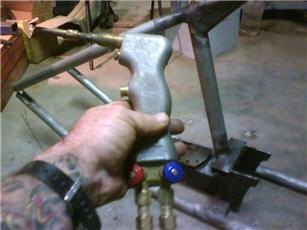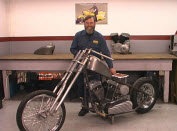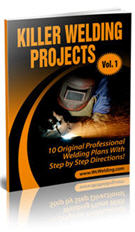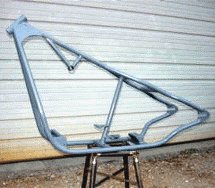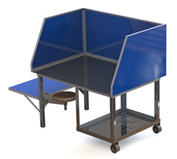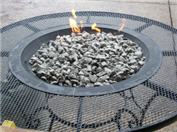Oxy Acetylene Welding and Sheet Metal!
Oxy fuel or oxy acetylene welding are gas welding procedures that were invented in the early 1900's. And this welding process is still very popular today, mainly because it does not require much equipment, and does not require power.
So the question is...
'Why Would I Ever Want To Gas Weld Anything?'
After all, MIG welding and TIG welding is something you might know how do do well and the results can be very satisfying. They are great welding procedures, MIG being the easiest to learn by far!
But it really comes down to this: How much work do you want to do? A MIG weld is very hard to work off. For example, if you need to run a consistent bead across a panel you'll be welding for hours in some cases.
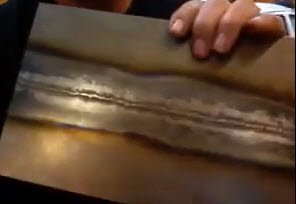
Mig welding wire is small. But the problem with MIG welding sheet metal is that you are pushing a lot of wire through your nozzle, and there is a lot of heat.
So, if you have an 1/8th inch sheet and it's heated up you're going to have a lot more heat, and with a lot more heat you get a lot more distortion.
You're going to get distortion because there is so much of the heat being generated from your MIG weld across your 1/8 inch sheet metal. And you have so much material from this welding process that when it cools down it's effecting a larger area (of your sheet metal or panel). I hope that makes sense?
This is why I am making an argument for using gas because Oxy acetylene welding doesn't effect your material as much.
Fusion Gas Welding and Filler Rod:
If you are fusion welding it won't effect your material as much as MIG or TIG either because you are not adding very much filler rod.
As a matter of fact I use 035 filler rod. Back in the day I was told by an old school welder that using the 035 wire is a good idea because this wire replaces the properties that you're burning off as you're gas welding, or at least helps replace them.
I am not 100% sure that it replaces the properties but I do know that it helps.
But one of the things you've got to look at too is your heat-effected zone. This is your zone right here:
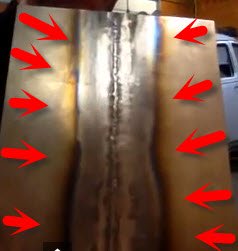
The heat effected area is wherever the color is (see arrows as they sort of outline the beginning of the coloring above).
Keep in mind that outside of the heat effected area is also being effected because it is being pulled here as it shrinks...
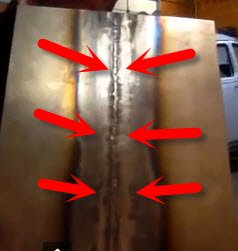
And since it's being pulled as show above it's also being pulled here:
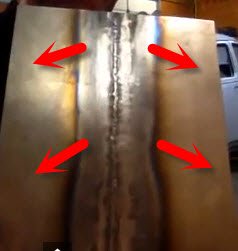
Since this pulling action occurs on your panel many times you'll get a little wrinkle further up your panel.
Working The Area:
You're going to have to work this welded area. In other words you are going to 'replenish' the welded area by working it with an anvil or a hammering dolly.
Work it slowly. I've seen a lot of metalworkers get to this portion of their work and just smash on the weld. Work a small part of the 'proud' side of your weld off and then go over it lightly with your hammer or dolly.
You will end up with too much stretch in your panel if you go in there and smash down the weld, and that then serves you a nice big problem where you now have to try and shrink your material by heating it up once again.
So don't go bananas. Just take your time and take good care of your material and you'll save yourself a lot of trouble.
Oxy Acetylene Welding Tips:
- Concentrate on a good weld.
- Look at your heat effected zone (as described above).
- Go into repairing it; take a little bit of the 'proud' side of the weld off.
Side Bar: See image below. Notice that this is not ground down, it's just been wire brushed. And very little has been knocked down. I could knock this down probably 80 grit on a soft pad.
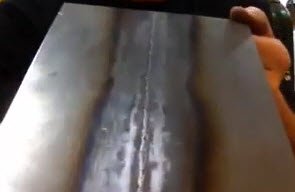
Good Penetration.
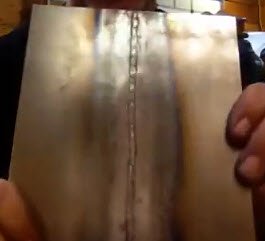
You want good penetration of your weld on both side sides so that you don't end up with a problem later
on. The image above is the backside of your weld on the panel and it shows an example of good weld penetration from oxy acetylene welding.
You want good penetration on both sides because when you begin to work on your welded side you might end up taking too much off and you won't have enough penetration on the back side to support it.
These are all little areas of welding a panel or sheet metal that you have to think about.
Oxy Fuel Welding Torches:
I used to have a Smith torch but I ended up buying an Airco. But now I use Henrob DHC 2000. It's a great torch.
The Henrob has a good flame and controls. There's some better ones out there
that are smaller and lighter but I like this one very much. I hold it
like I was drawing so that the weight doesn't effect me very much unless
I was doing an entire panel all the way around a car or something like
that.
Just For Fun. Pictures Of Older Oxy Acetylene Torches:
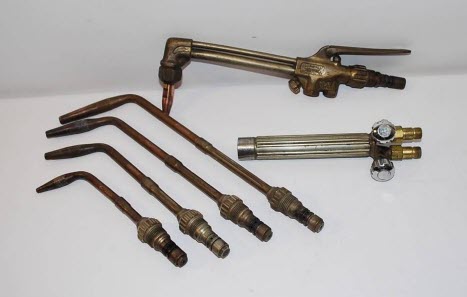
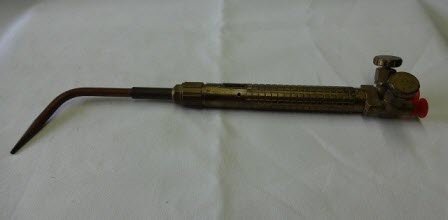
Do You Have Any Oxy Acetylene Tips?
If you have information to share on Oxy Fuel or Acetylene welding please do so here...
What Other Welders Have Said
Click below to see contributions from other visitors to this page...
3 Problems With My Oxy Acetylene Welding Torch! 




I have started making wire sculptures. I join the wires by gas (Oxy-Acetylene) welding process.
In the beginning, I used an Indian made ‘Gas Torch’. …
Recommended Article:
Copyright WcWelding.com All Rights Reserved.
Welding Plans:
New! Welding Table
New! Log Splitter
Top Projects:
